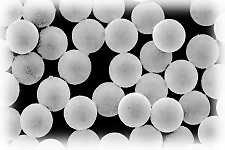Magnetic Silica particles - a fast method for DNA/RNA purification and Protein separation
Separation techniques are goinig to be more and more important in biotechnology, to get on cost efective, simple, reproducable ways and by using automatisation systems. The large surface area of 50m2/g provides a high capacity to bind cells, bacteria, DNA/RNA, proteines or antibodies.These paramagnetic uniform non porous silica particles are with 80% magnetit content allow simple magnet separation. The are supolied in double destilled H2O, but can be offered in powder form on request.
main applications of the chemical modifications:
Silanol:DNA & RNA techniques, purification of genomic DNA, plasmid DNA, viral DNA or PCR products.
DNA/RNA bind to the silica beads under high salt conditions as 4 mol NaL or 5 mol GuSNC.
Silanol-ROB: especially developed for use of DNA/RNA separation in robotic systems.
Carboxyl: binding of bioactive substances by the Carbodiimide methode
Amino:binding of bioactive substances by the Carbodiimide methode
Cyanuric replaces Chloromethyl due to better binding characteristics
Streptavidin: biotin labeled molecules
Biotin:avidin/streptavidin labeled molecules
available on request: magnetic silica beads with Protein A andG, Oligo(dt), calf tymus DNA, Albumin and GaM (Fc).

